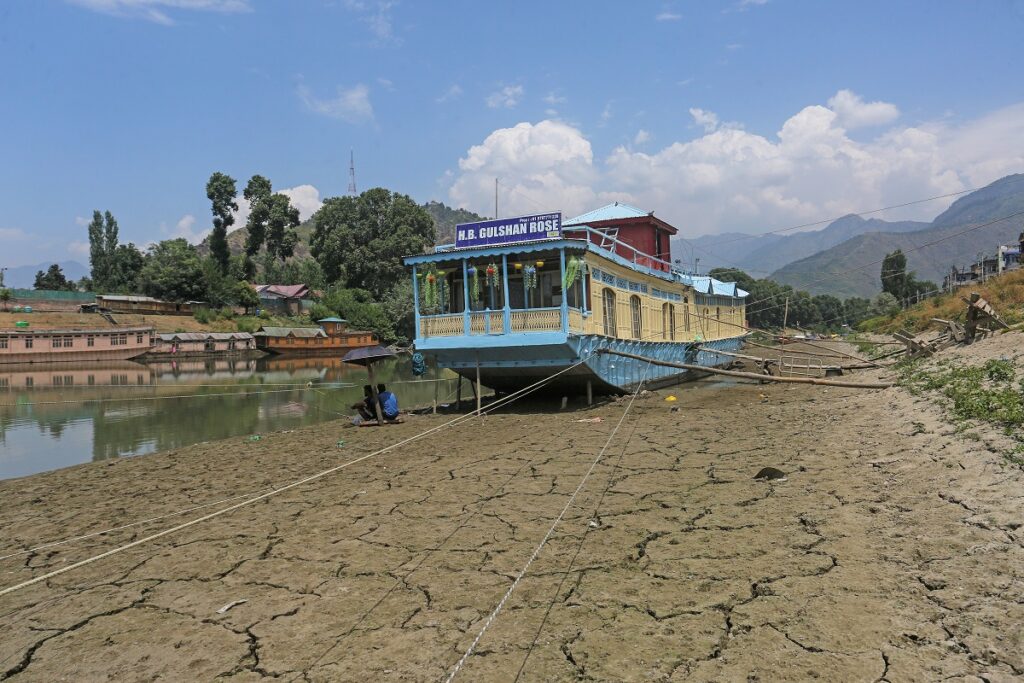
Srinagar- Kashmir has witnessed a dry winter this year with the months of January and February recording a precipitation deficit of around 80 per cent, which has raised the possibility of drought in the valley this summer, the MeT department officials said.
Several water bodies are flowing below the zero level mark at many places while some springs in south Kashmir have dried up completely due to the receding water table, they said.
“There has been 79 per cent deficient precipitation in the month of January and the situation in February so far is worse. If the dry weather continues, it is going to cause problems for the residents of the valley as there won’t be enough water for drinking or irritating the fields,” a MET department official said.
An official of the Irrigation and Flood Control Department said the water level in River Jhelum and several other water bodies was more than a metre below the usual water level for this time of the year.
“If it does not rain or snow in the next fortnight, there is a possibility of a crisis with regards to water for drinking and irrigation purposes,” he added.
Social media is flooded with videos and images of dried up water bodies with Achabal springs in south Kashmir having dried up completely.
The river bed of Jhelum is visible at many places, especially upstream in south Kashmir areas while the water level downstream in north Kashmir is alarmingly low. The situation is similar in other major streams of the valley.
The lack of enough snowfall has forced authorities to postpone the fifth edition of Khelo India Winter Games which were scheduled to begin from February 22.
While most of the Gulmarg bowl is bereft of snow, the higher reaches of the famous skiing destination does not have enough snow for safe conduct of sports activities.
‘Declining Snow Threatens Economy, Ecology’
Renowned earth scientist and Vice-Chancellor of the Islamic University of Science and Technology (IUST) Prof Shakeel Romshoo on Tuesday said that snowless winters during the past five years have pushed Kashmir to the brink.
In an exclusive interview, Prof. Romshoo said that Kashmir has experienced a significant decline in snowfall over the past five years, particularly during the peak winter season. This has led to the current alarming situation. “Snowfall is a major source of water for Kashmir’s population. With the pervasive lack of snow, rivers, tributaries, and streams are drying up. This could severely impact the tourism sector, horticulture, and food security systems in Kashmir, with far-reaching economic implications,” Prof. Romshoo said.
Asked about the drying up of the Achabal water stream, Prof. Romshoo explained that geological factors could be at play. The mountains from which these streams originate are shallow, and their flow is sustained by snow accumulation. “Over the past several years, we have witnessed dry winters with little to no snowfall. This is the primary reason why streams are drying up,” he said.
Meanwhile, the Jammu and Kashmir government has taken up the issue of the drying Achabal stream with the Geological Survey of India (GSI).
The sources said that the Chief Secretary has directed the General Administration Department to request the GSI to dispatch a team of experts to the region. The team will investigate the causes of the crisis and recommend remedial measures.
The famous Achabal waterfall, a key water source in the region, has completely dried up, leaving many communities struggling for water. Reports indicate that 65% of water sources in the area are severely depleted, creating drought-like conditions.
Environmental experts attribute the crisis to climate change and global warming, which have significantly impacted the lower Himalayan region.
The Jhelum River, Kashmir’s primary water source, has recorded its lowest water levels in decades. Groundwater reserves and other water bodies are also depleting rapidly. While temporary conservation measures have improved some wetlands, such as Hokarsar, experts warn that the crisis will worsen without a comprehensive water management policy.
“We need a holistic approach to managing water resources, especially for rivers like the Jhelum and Chenab. A structured policy will help regulate water release and conservation,” said Javaid Khursheed, a research scholar in environmental sciences.
The effects of global warming are being felt worldwide, with extreme weather patterns causing both floods and droughts. Experts emphasize that preserving wetlands, lakes, and rivers is crucial to mitigating the impacts of climate change. Khursheed urged both the government and citizens to take immediate action to prevent further environmental degradation.
“Pollution in our riverbeds must be addressed at every level. Sustained conservation efforts are vital for the survival of our water bodies,” he added. (With inputs from KNO)
Follow this link to join our WhatsApp group: Join Now
Be Part of Quality Journalism |
Quality journalism takes a lot of time, money and hard work to produce and despite all the hardships we still do it. Our reporters and editors are working overtime in Kashmir and beyond to cover what you care about, break big stories, and expose injustices that can change lives. Today more people are reading Kashmir Observer than ever, but only a handful are paying while advertising revenues are falling fast. |
| ACT NOW |
| MONTHLY | Rs 100 | |
| YEARLY | Rs 1000 | |
| LIFETIME | Rs 10000 | |











